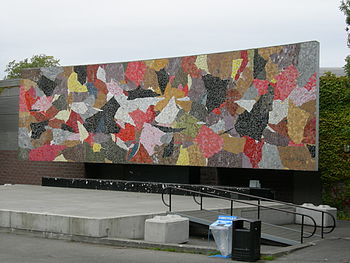Collage
| Art Appreciation and Techniques (#ART100) | |
|---|---|
| Artistic media: Two-dimensional art | Overview | Introduction | Drawing | Painting | Printmaking | Collage | Summary |
Collage is a medium that uses found objects or images such as newspaper or other printed material, illustrations, photographs, even string or fabric, to create images. It also refers to works of art (paintings, drawings and prints) that include pieces of collage within them. Collage was made popular in western art history by Pablo Picasso and the cubists. The German artist Kurt Schwitters used collage as the dominant formal element in his works from the 1930’s. His work Opened by Customs is an excellent example of the importance of collage to the modern art movement in Europe before World War II.
Artist Romare Bearden used collage to comment on urban life and the black experience in America. His Patchwork Quilt presents us with a figure in profile reminiscent of Egyptian painting. The starkness of the black figure surrounded by a collage of patterned fabric and dark background color creates a shallow space and dynamic composition.The Japanese American artist Paul Horiuchi began as a painter but by mid career used collage almost exclusively. Mesa from 1960 is an abstract rendition of the geologic feature: an isolated hill with steeply sloping sides and a flat top. Horiuchi’s art is a successful blending of the formal elements of cubist ideas with the oriental aesthetic of his Japanese heritage. His most ambitious piece is the Mural Ampitheatre in Seattle, Washington, US, a huge glass mosaic commissioned for the site of the 1962 World’s Fair.
